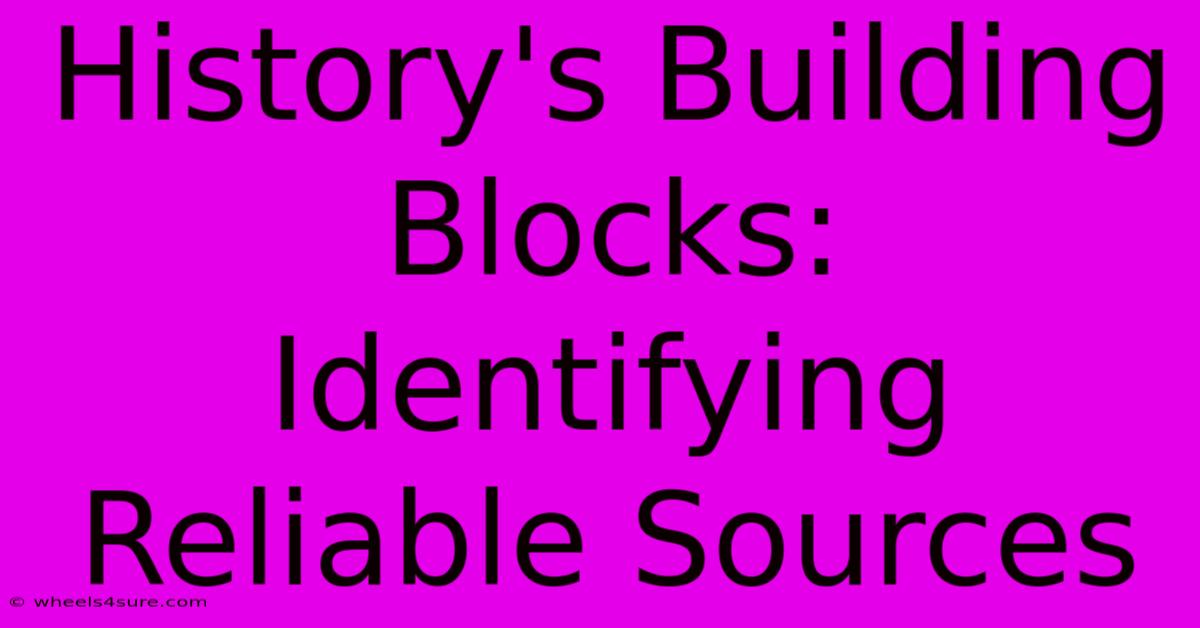History's Building Blocks: Identifying Reliable Sources

Table of Contents
History's Building Blocks: Identifying Reliable Sources
History isn't just a collection of dates and names; it's a complex narrative built from countless individual accounts, artifacts, and interpretations. Understanding the past accurately requires discerning fact from fiction, and that starts with identifying reliable sources. This article explores the crucial skills needed to evaluate historical sources and build a strong foundation for your own historical understanding.
Why Source Reliability Matters
Before diving into the how-to, let's understand the why. Using unreliable sources leads to inaccurate conclusions, perpetuating myths and misinformation. Imagine a historian relying solely on a biased memoir to understand a significant historical event. The resulting narrative would be skewed, lacking a balanced perspective. Reliable sources provide the necessary evidence to support claims, ensuring historical accuracy and providing a richer, more nuanced understanding of the past.
Types of Historical Sources: A Quick Overview
Historical sources are broadly classified into two categories:
Primary Sources:
These are materials created during the time period being studied. They offer firsthand accounts and insights. Examples include:
- Original Documents: Letters, diaries, speeches, legal documents, and government records.
- Artifacts: Objects from the past, such as tools, clothing, artwork, and buildings.
- Oral Histories: Recorded interviews with people who lived through a specific historical event.
Secondary Sources:
These are interpretations and analyses of primary sources. They are created after the historical event and often offer a broader perspective. Examples include:
- Scholarly Articles: Peer-reviewed articles published in academic journals.
- Books: Histories written by experts in the field.
- Documentaries: Films that explore historical topics.
Evaluating Source Reliability: A Checklist
No source is inherently perfect. Critical evaluation is crucial. Here's a checklist to guide your assessment:
- Authorship: Who created the source? What was their perspective, background, and potential biases? Consider their social standing, occupation, and relationship to the events described.
- Audience: Who was the intended audience? This can influence the content and tone of the source. A personal letter might contain more intimate details than a public speech.
- Purpose: Why was the source created? Was it to inform, persuade, or entertain? Understanding the purpose helps assess potential biases or agendas.
- Context: When and where was the source created? What were the prevailing social, political, and cultural conditions? Historical context is essential for proper interpretation.
- Content: What information does the source provide? Is the information consistent with other evidence? Look for internal inconsistencies or contradictions.
- Bias: Does the source exhibit bias? All sources have some degree of bias, but some are more overtly biased than others.
- Evidence: What evidence supports the claims made in the source? Is the evidence credible and reliable?
Cross-Referencing and Corroboration
No single source should be taken at face value. Always cross-reference information with multiple sources. Look for corroboration – evidence that confirms or supports the information from other sources. Discrepancies between sources may indicate bias or inaccuracies. Investigating these inconsistencies can lead to a deeper understanding of the historical event.
Using Multiple Perspectives: A Balanced Approach
History is rarely black and white. It is crucial to examine multiple perspectives to gain a comprehensive understanding of the past. By consulting diverse sources representing different viewpoints, you can construct a more accurate and balanced narrative. This includes considering the perspectives of different social groups, genders, and ethnicities.
Conclusion: Building a Strong Historical Foundation
Identifying reliable sources is a fundamental skill for anyone interested in history. By carefully evaluating sources and cross-referencing information, you can construct a robust understanding of the past, informed by accurate and reliable evidence. Remember, the pursuit of historical knowledge is an ongoing process that requires critical thinking, careful evaluation, and a commitment to finding truth amidst the complexities of the past.

Thank you for visiting our website wich cover about History's Building Blocks: Identifying Reliable Sources. We hope the information provided has been useful to you. Feel free to contact us if you have any questions or need further assistance. See you next time and dont miss to bookmark.
Featured Posts
-
Moms Pass Salary Financial Stability For Your Family
Apr 03, 2025
-
The Unexpected Life Of Louis Therouxs Son
Apr 03, 2025
-
Mavy Legaspi A Look At His Age And Legacy
Apr 03, 2025
-
The Truth About Suzy Sheeps Father You Wont Believe It
Apr 03, 2025
-
Age De Pedri Hydrate Revitalize Rejuvenate
Apr 03, 2025
